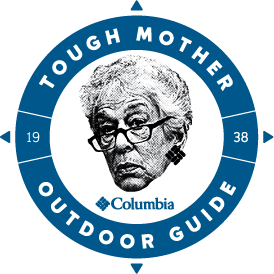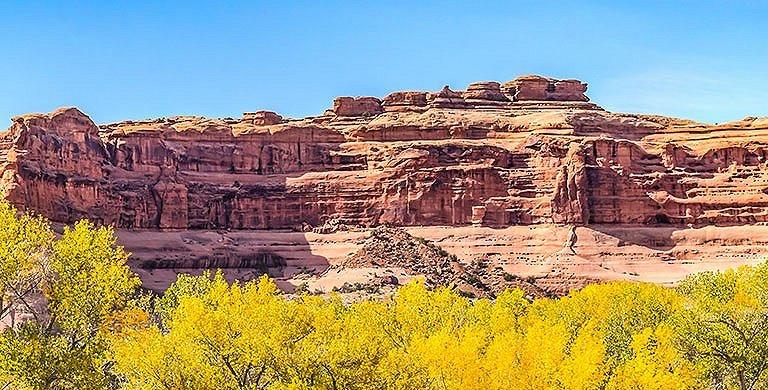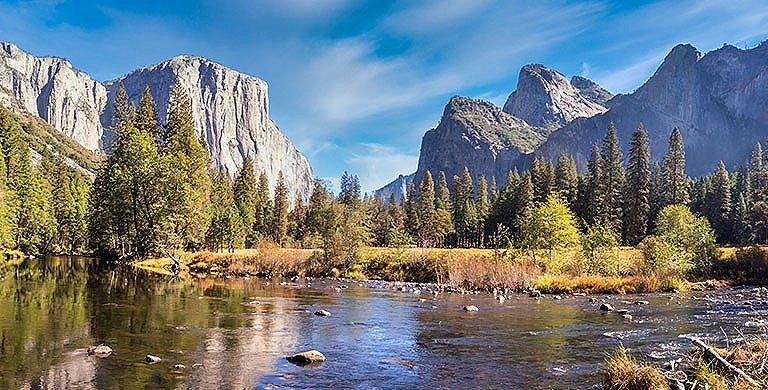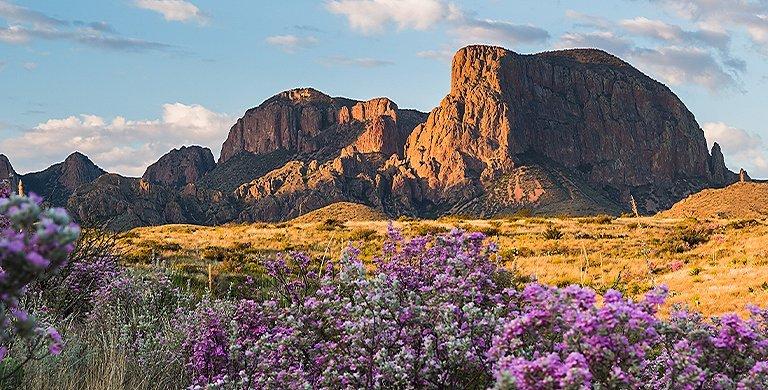EXPLORATION
National Parks: Your Most Frequently Asked Questions
From visitor stats to the history of our national park system, we answer your most pressing questions
BY: TROY ASPLUND
From taking in the exploding colors of changing leaves in the fall
to exploring pristine, snow-covered landscapes on cross country skis in the winter, our country’s national parks offer something for everyone, any time of year. But as you decide which park to put at the top of your to-visit list, you’re bound to have questions. So here are the answers to some of those questions you may have, and maybe some you hadn’t even thought of.
National park stats and visitor numbers
How many national parks are there?
There are 63 parks which bear the official title of “national park” in their name. These parks are spread across 31 states and two U.S. territories (American Samoa and the Virgin Islands). However, the National Parks System actually encompasses 420+ national park sites across every state, and include locations in Puerto Rico, the Virgin Islands, America Samoa, and Guam. There are 20 different park types that comprise the National Parks System including National Parks
, National Memorials, National Battlefields, and many more. For more information on the entire National Parks System and the types of parks and locations protected by the NPS, you can visit the National Park Foundation website.
What state has the most national parks?
California has more national parks than any other state with nine—one more than Alaska. Utah comes in third with five national parks. Among the Golden State’s most notable parks are the ever-popular Yosemite, Joshua Tree, and Sequoia, home to the world’s largest trees.
What is the largest national park?
The largest national park is Alaska’s Wrangell-St. Elias National Park and Preserve, measuring 13.2 million acres. This massive park of unmatched wilderness holds nine of North America’s 16 highest peaks, including the continent’s second-highest peak, Mt. St. Elias (18,008 feet).
The park also encompasses the nation's largest protected active glacial complex, and includes ecosystems from temperate rainforests to tundra, where you can come across everything from the largest concentrations of Dall sheep in North America to both black and brown (grizzly) bears —make sure to always be “bear aware.”
The park also encompasses the nation's largest protected active glacial complex, and includes ecosystems from temperate rainforests to tundra, where you can come across everything from the largest concentrations of Dall sheep in North America to both black and brown (grizzly) bears —make sure to always be “bear aware.”
What is the smallest national park?
The smallest national park is Gateway Arch National Park, at just under 200 acres in size. Located in St. Louis, Missouri, the park sits on the historic riverfront of the Mississippi River, and includes the iconic St. Louis Arch, which stands 630 feet high.
How many people visit national parks each year?
Approximately 91 million people visited our country’s 63 national parks in 2023.
What are the most visited national parks?
The most visited national park, by more than 8 million people, is Great Smoky Mountains National Park, with over 13.29 million visitors in 2023. Located across North Carolina and Tennessee, the park’s great popularity can be attributed to both its diverse landscape and easy accessibility, which is a major factor in attracting the most visitors to national parks.
While spring and especially summer are often the seasons that first come to mind when you think of visiting our country’s national parks, many parks draw visitors year-round—some more than others. Here are the Top 5 national parks most visited in 2023:
While spring and especially summer are often the seasons that first come to mind when you think of visiting our country’s national parks, many parks draw visitors year-round—some more than others. Here are the Top 5 national parks most visited in 2023:
- Great Smoky Mountains National Park (North Carolina and Tennessee): Over 13.29 million visitors
- Grand Canyon National Park (Arizona): Over 4.73 million visitors
- Zion National Park (Utah): Over 4.62 million visitors
- Yellowstone National Park (Wyoming): Over 4.5 million visitors
- Rocky Mountain National Park (Colorado): Over 4.11 million visitors
What are the least crowded national parks?
The least crowded, or least visited, national park is Alaska’s Gates of the Arctic National Park and Preserve, with barely 11,000 visitors per year. The lack of crowds are almost entirely due to the park’s remoteness. Whether backpacking or flightseeing, exploring that remoteness reveals stunning mountain ranges, untamed rivers, and vast Alaskan tundra.
Here are the other parks that make up the Top 5 least crowded parks list—all of them also known for their remote, secluded locations:
National Park of American Samoa – With just over 12,000 visitors per year, this park protects rainforests, coral reefs, and volcanic peaks in the American Samoa islands.
Lake Clark National Park and Preserve, Alaska – Attracting less than 17,000 annual visitors, this park, accessible mostly by plane, is home to glaciers, volcanoes, and abundant wildlife.
Kobuk Valley National Park, Alaska – This remote fly fishing destination, which encompasses rolling tundra, sand dunes, and the Kobuk River, sees around 17,500 visitors each year.
Isle Royale National Park, Michigan – This island park in Lake Superior is accessible only by boat or seaplane, which limits annual visitors to just 29,000.
For those looking for smaller national park crowds, winter and fall are often better times to visit than spring and summer—just make sure to check online for any closures or limited operations. But you can even avoid large crowds during busy summer months by visiting lesser-known parks or exploring areas of popular parks that are off the beaten path. Visiting on weekdays or early mornings will also help you avoid peak crowds as well.
Here are the other parks that make up the Top 5 least crowded parks list—all of them also known for their remote, secluded locations:
National Park of American Samoa – With just over 12,000 visitors per year, this park protects rainforests, coral reefs, and volcanic peaks in the American Samoa islands.
Lake Clark National Park and Preserve, Alaska – Attracting less than 17,000 annual visitors, this park, accessible mostly by plane, is home to glaciers, volcanoes, and abundant wildlife.
Kobuk Valley National Park, Alaska – This remote fly fishing destination, which encompasses rolling tundra, sand dunes, and the Kobuk River, sees around 17,500 visitors each year.
Isle Royale National Park, Michigan – This island park in Lake Superior is accessible only by boat or seaplane, which limits annual visitors to just 29,000.
For those looking for smaller national park crowds, winter and fall are often better times to visit than spring and summer—just make sure to check online for any closures or limited operations. But you can even avoid large crowds during busy summer months by visiting lesser-known parks or exploring areas of popular parks that are off the beaten path. Visiting on weekdays or early mornings will also help you avoid peak crowds as well.
History of our national parks
What is the National Park Service?
The National Park Service (NPS) is the government agency entrusted with the care of our national parks. Created by an act signed by President Woodrow Wilson on August 25, 1916, the NPS is responsible for:
- Safeguarding parks and protecting the natural and cultural resources within them
- Connecting visitors with park stories through educational programs, exhibits, and interpretation
- Fostering an appreciation for parks and conservation for future generations
- Providing recreational activities like hiking, camping, and exploring for park visitors
- Collaborating with other government agencies, nonprofit organizations, and volunteers
Who is in charge of the National Park Service?
The National Park Service director leads the National Park Service in its mission. The 19th and current director is Charles F. “Chuck” Sams III, who was sworn in on December 16, 2021.
What is the National Park Foundation?
National Park Foundation (NPF) is the official nonprofit partner of the National Park Service (NPS), acting as a bridge between the National Park Service and the public. Chartered by Congress in 1967, the foundation’s purpose is to directly support the NPS in protecting and enhancing America's national parks, for the present and future. They achieve this through:
- Conservation and Preservation: Raising funds to support critical conservation and preservation efforts within national parks
- Education and Outreach: Sponsoring educational programs and initiatives to connect people with national parks to inspire appreciation of them
- Community Engagement: Fostering community engagement and volunteerism in national parks
- Fundraising and Philanthropy: Raising private funds to supplement the National Park Service's budget through donations from individuals, foundations, and corporations to help address park needs
What was the first national park?
Yellowstone National Park was our country’s very first national park.
When was Yellowstone National Park established?
The park was established on March 1, 1872, with the signing of the Yellowstone National Park Act.
Who established Yellowstone National Park?
President Ulysses S. Grant is credited with establishing Yellowstone National Park. The act set aside two million acres of land from the Montana and Wyoming territories for “the benefit and enjoyment of the people.” That land was placed under the control of the Secretary of the Interior, who was charged with preserving the timber, mineral deposits, and other resources within the park.
Who created the national park system?
While President Grant is credited with creating the first national park and President Wilson credited with creating the National Park Service, no one person is officially credited with creating the national park system. Outside of Grant and Wilson, many refer to John Muir, a prominent conservationist and explorer, as the "Father of Our National Park System." It was Muir’s activism and lobbying efforts that helped lead to the establishment of Yosemite National Park in 1890.
What is the most recently added national park?
The newest national park is New River Gorge National Park and Preserve in West Virginia. First designated as a national river in 1978 by President Jimmy Carter, its designation was then upgraded to a national park and preserve in December 2020.
How is a new national park created?
Creating a new national park is a lengthy process with several steps. Once a park is identified, whether through a presidential recommendation or grassroots effort, a feasibility study is conducted to evaluate the area’s potential, which is followed by public meetings and hearings for public input and opinions. Next, a bill is drafted and must be approved by both the House and Senate, and then signed by the president. Once the bill becomes official, the government begins acquiring the land and developing a management plan before the park is open to visitors. It’s a process that can take years, if not decades, to complete.
Why are national parks important?
The importance of our country’s national parks cannot be overstated—first and foremost, they protect our country’s most beautiful areas and natural wonders for generations to come. The protected areas of our national parks are vital for many reasons:
Environmental protection: Safeguarding irreplaceable natural wonders as well as areas that act as sanctuaries for diverse wildlife populations and ecosystems
Conservation: Protecting clean air and water as well as vast landscapes that help regulate the environment through the absorption of carbon dioxide
Historical and cultural preservation: Preserving significant historical or cultural landmarks for scientific study, ensuring stories from the past are accessible to the public
Outdoor recreation and education: Fostering appreciation for nature and a sense of stewardship through outdoor recreation and educational programs offered by park rangers
Health and wellness: Creating places to escape the stress of daily life, reconnect with nature, and engage in activities that promote well-being
Economic impact: Generating revenue for local businesses through tourism, while also creating jobs and supporting infrastructure development in the area
Environmental protection: Safeguarding irreplaceable natural wonders as well as areas that act as sanctuaries for diverse wildlife populations and ecosystems
Conservation: Protecting clean air and water as well as vast landscapes that help regulate the environment through the absorption of carbon dioxide
Historical and cultural preservation: Preserving significant historical or cultural landmarks for scientific study, ensuring stories from the past are accessible to the public
Outdoor recreation and education: Fostering appreciation for nature and a sense of stewardship through outdoor recreation and educational programs offered by park rangers
Health and wellness: Creating places to escape the stress of daily life, reconnect with nature, and engage in activities that promote well-being
Economic impact: Generating revenue for local businesses through tourism, while also creating jobs and supporting infrastructure development in the area
National park passes and info
Are there guided tours or ranger-led programs at national parks?
Many national parks do offer both guided tours and ranger-led programs, which are both great ways to learn a park’s history as well as significant facts about the area’s geology and ecology. The availability of these programs do vary by park, however, so it’s best to always check the website of the specific park you are visiting.
Ranger-led programs often include walks, hikes, and other activities arranged by park rangers, who are experts on just about everything related to the park they work in. And while the National Park Service itself doesn’t directly offer guided tours, many parks work with companies that provide guided tours, from bus tours to day hikes.
Ranger-led programs often include walks, hikes, and other activities arranged by park rangers, who are experts on just about everything related to the park they work in. And while the National Park Service itself doesn’t directly offer guided tours, many parks work with companies that provide guided tours, from bus tours to day hikes.
Where do I buy a national park pass?
National park passes can be purchased at over 1,000 federal recreation sites. But how do I get a national park pass ahead of my trip, you’re wondering? Easy. Order online from the usgs.gov website or by phone at 888-275-8747. Give it three-ish weeks for delivery.
What is the national park annual pass?
Both the standard pass (good for seven days) and annual pass can be purchased for individual parks. Annual passes can also be purchased for some select park groups as well. But for annual access to every national park, the America the Beautiful pass is the one you want.
What is the America the Beautiful pass?
The America the Beautiful pass covers entrance fees and day-use fees at federal recreational sites, including national parks, for one year. They are available for anyone to purchase, but are available to several groups FREE of charge. Those groups are:
- Current U.S. military and dependents
- U.S. citizens and permanent residents with permanent disability
- U.S. fourth graders
- Federal recreation site volunteers with 250 service hours
What is the America the Beautiful lifetime pass?
The America the Beautiful lifetime pass covers entrance fees and day-use fees at federal recreational sites, including national parks. They are available to seniors for purchase, and offered to Gold Star Family members and veterans for FREE.
What is the national parks pass for seniors?
Seniors (62 years old or older) can buy the America the Beautiful Annual Senior Pass or America the Beautiful Lifetime Senior Pass, both of which cover entrance fees and day-use fees at federal recreational sites, including national parks.
How do I get a lifetime pass to national parks?
The America the Beautiful lifetime passes are only available to seniors for purchase, and offered to Gold Star Family members and veterans free of charge.
How do I make reservations for campsites and permits in the national parks?
The recreation.gov website is the primary place to reserve campsites and buy many national park permits. But you should also check the website of the park you will be visiting for additional reservation information, as some parks have their own reservation system and may require permits for specific activities like backcountry camping or wilderness access.
Need some gear to explore our national parks?
Check out Columbia Sportswear’s hiking clothes.
Check out Columbia Sportswear’s hiking clothes.



